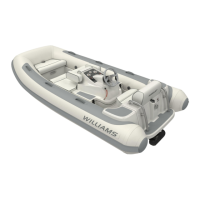williamsjettenders.com
Winterising/Dry Storage
Store the boat covered in a clean, ventilated and dry place that is not affected by major
variations in temperature or humidity. For full information on servicing please refer to the
Textron engine service manual.
Buoyancy Tube
Prior to storing over the winter periods the buoyancy tubes must be deflated and hosed down
with fresh water, removing any small stones and weed from luffing track, then allowed to dry.
Use a proprietary tube cleaner and polish to ensure optimum condition. Store with the tubes
lightly inflated where possible.
Maintenance of the Hull & Deck
Wash the deck regularly using a mild detergent in warm water and hose down to remove sand
etc. The hull and deck should be regularly polished using a good quality gelcoat polish to
minimise fade and UV chalking.
Battery
The battery used in the Turbojet is of the dry cell type. This means that the electrolyte content
is absorbed in a special fabric which requires no ‘topping up’ and is leak proof in any position.
When the boat is not being used for an extended period of time, disconnect the earth terminal.
A trickle-charging device, such as an ‘accumate’, will extend battery life.
Fuel System
Fuel will become stale over a period of several months. A full fuel tank prevents moisture and
mildew from developing within the tank. Fuel begins to break down after approx. 30 days.
Adding a fuel stabilizer in the recommended ratio will minimise this.
Cooling System
Flush the open loop water circuit to remove salt, sand, shells and other contaminants that may
be trapped in the raw water cooling circuit (refer to After Use: Flushing Procedure section).
Measure the anti-freeze content of the engine coolant with a commercially available anti-freeze
tester. A 50/50 mixture of distilled water to propylene glycol provides sufficient frost protection
to approx. -37°C. Run the same 50/50 antifreeze mixture through the open loop system using
the flush attachment and a suitable container.
Engine Oil Change
It is important to change the oil. Used engine oil contains water, unburned fuel and small metal
particles. When old oil is left in the engine for longer periods, corrosion and degradation of
bearings within the engine may occur.
Conserving the Cylinders
Unscrew the spark plugs and fill approx. 10ml of clean engine oil directly into each spark plug
bore. Crank the engine a few times with the starter. Screw in the spark plugs again.
Conserving the Turbo Wastegate Flap
To prevent the wastegate flap from binding/jamming, spray a corrosion-protection agent onto
the shaft and bush.
Grease Cables
Grease all control cables at both ends and exercise to ensure good coverage
General Corrosion Protection
Apply Vaseline, dielectric grease or a similar white grease to battery isolator switch, upholstery
press studs and running light pole base. Use maintenance spray on key switch. Apply a
proprietary corrosion guard to engine, electrical connections, under helm and around jet pump
area.
Full Inspection Maintenance Table
•
Requires basic mechanical and/or electrical knowledge
•
Refer to Textron Engine Manual
•
Requires advanced mechanical and/or electrical knowledge
•
Replace
Item Procedure
Every
use
Break-in
period
12 hours
Regular intervals
60 hr 120 hr 360 hr
End of
year
Valve Clearance
Inspect/Adjust •
• •
Spark Plugs
Replace •
• • •
Ignition Coils
Replace •
•
Waste Gate Valve
Adjust •
•
Air Filter
Inspect •
•
Engine Oil
Inspect Level •
• •
Engine Oil & Filter
Replace •
• • •
Engine Coolant
Inspect •
• •
Engine Coolant
Replace •
After 4 years
Seawater
Cooling Circuit
Flush
• • •
Engine
Sacrificial Anode
Inspect •
• •
Engine Corrosion
Protection
•
• •
Cooling/Oil/
Air Hoses
Inspect
• • •
Engine Mounts
Inspect/Replace
• • •
Spark plugs, Fuel
Stabilizer, Engine
Internal Preservation,
Exhaust and Fuel
Systems
Inspect •
•
Impeller/Pump
Inspect
• •
Pump Anodes
Inspect/Replace
• • •
Bilge
Inspect/Clean
• •
Electrical
Connections
Inspect/Clean/
Lubricate
• •
Fuel System
Inspect
• •
Fuel Filter
Cartridge
Replace
•
Ignition/
Battery Switch
Inspect/Clean/
Lubricate
• • •
Reverse Cable
Inspect/Clean/
Lubricate
• • •
Steering Cable
Inspect/Clean/
Lubricate
• • •
Shaft Seal
Lubricate
Check level every 10 hours. Top up if necessary

